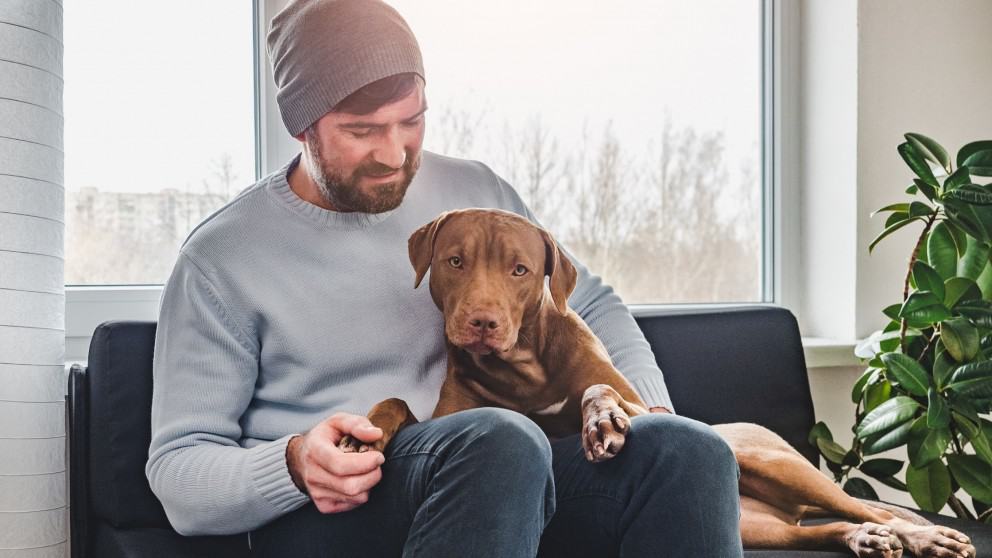What you need to know about adopting a “bully breed”

Tail wagging, tongue flapping and kisses are just a few of the reactions you can expect to come home to when you adopt a bully breed. These sturdy, active dogs make wonderful companions. Unfortunately, unaware pet owners relinquish their bully breeds to shelters too often because they didn’t realize the commitment required to own such a dog. Before you bring a bully breed into your life, make sure you know all the facts about these dogs. Are they good with children and other people? How much time and attention do they really need? These are just a few questions that should be pondered when considering adopting a bully breed.
Bully breeds have normal canine anatomy.
There are a lot of myths about these breeds’ physical make-up. From claims that they come equipped with powerful jaws that lock like a crocodile to theories that they have swelling brains that make them go crazy, it’s no wonder bully breeds have a somewhat spotty reputation. Dr. I. Lehr Brisbin of the University of Georgia researched pit bull mixes and a variety of similar breeds and concluded they have the same anatomy as any other dog, including that of a harmless-looking teacup Chihuahua. Rest assured, when you adopt a bully breed, he doesn’t come equipped with supernatural anatomy.
They need plenty of high-activity exercise.
As is true with most other dogs, a bored bully can be a bad bully. If you prefer slow living, a breed in this category is probably not the dog for you. Also, remember that you should never have your bully breed off-leash in public, so finding open spaces where he can run free might pose a challenge. If you don’t have a fenced-in yard but have space, a dog run makes an excellent option, as does a doggie treadmill. Just remember to supervise all of your dog’s activities.
It’s a given you must provide lots of love to a bully breed, but what about space, time, and money? Most bully breeds will do OK in an apartment and can succeed in an urban setting as long as they get plenty of exercise and at least 30 minutes of outdoor activity on a daily basis. Pit bull mixes are especially notorious for escaping, so if you have a fenced-in yard for playtime, make sure it’s secure and that there aren’t any loose boards your bully could use as an escape route. Consider the height of your enclosure too, since some bully breeds are excellent jumpers.
As with any breed, they come with some health concerns.
Providing the best care for a bully breed doesn’t differ much from any other breed. They all need annual veterinarian exams and vaccines and should be fed a healthy diet on a regular schedule. These breeds are typically very fit with few health concerns. Joint problems are a common issue some bully breeds might face due to their highly active nature. To minimize the chance of future complications, try to walk your dog on dirt or grass since asphalt is harder on joints. Also, try to warm him up with a short 5 to 10-minute walk before any strenuous activity.
Some homeowner’s insurance & renter’s policies exclude bully breeds or mixes.
The annual cost of owning a bully breed will be about the same as with any other dog, plus a few extra considerations. Before you adopt, find out if your homeowner’s insurance includes an exclusion on pit bull mixes or other breeds; you may need to pay an additional premium to call one of these dogs part of the family. Likewise, if you rent, check with your landlord to make sure you can have a bully breed in your building.
The adoption process for bully breeds is more rigorous.
Any reputable shelter will put you through a thorough screening process before allowing you to adopt a dog, but the process is usually more rigorous for someone looking to take home a bully breed. Don’t be offended if a shelter questions your motives in adopting pit bull mixes and other breeds with a history of abuse or dog fighting. Shelters could request a list of references along with a home visit to see where your adopted bully will live. You should also be prepared to answer a detailed questionnaire in which you will be asked things like why you want to adopt a bully breed and your history as a pet owner.
It may be surprising to know there are actual laws on the books in many cities and counties regarding dogs, but thanks to fear and irresponsible pet ownership, many local governments have enacted breed-specific legislation (BSL) to curb perceived issues with bully breeds. The easiest way to find out if your town has passed BSL is to contact your local animal control facility. The shelter where you plan to adopt should know the regulations also, but if you’re adopting out of town, it’s best to check for yourself first.
They are super loving companions.
Bully breeds are generally very loving and loyal companions. They normally form close bonds with their owners and will constantly be around your home. These breeds won’t like being relegated to the backyard or left alone for long periods of time. Be prepared to commit at least two hours a day of undivided attention to your bully breed to ensure his happiness. Remember, you can’t judge an entire breed by a few negative news reports. If you’re ready to adopt a loving and active dog, you will have a faithful companion for life in a bully breed.
With whatever breed you get, make sure you get all the coverage you need, even supplemental benefits. Keep your pup happy!
Do you have a french bulldog? Read this article to know more about their health issues.



